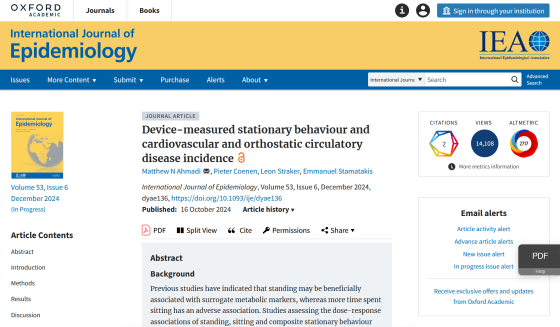Standing desks alone may not be enough to avoid health problems caused by sitting

Modern people often work or enjoy hobbies while sitting for long periods of time, and there are concerns that a sedentary lifestyle can have a negative impact on health. Some people have introduced standing desks that allow them to work while standing to improve their sedentary lifestyle, but a new study has shown that 'using a standing desk alone cannot avoid all of the health problems caused by sitting for long periods of time.'
Device-measured stationary behavior and cardiovascular and orthostatic circulatory disease incidence | International Journal of Epidemiology | Oxford Academic

Your Standing Desk Might Actually Be as Bad as Sitting All Day : ScienceAlert
https://www.sciencealert.com/your-standing-desk-might-actually-be-as-bad-as-sitting-all-day
In recent years, the introduction of standing desks has been touted as a way to improve the health of desk workers who lead sedentary lifestyles. A research team from Australia and the Netherlands investigated the effect of standing and sitting time on the incidence of cardiovascular disease and orthostatic circulatory disease.
The study used exercise data and medical histories from 83,013 participants collected from the UK Biobank , a large biobank in the UK. The subjects' standing and sitting time was measured using accelerometers worn by the subjects, and cardiovascular disease was defined as coronary heart disease , heart failure, and stroke, and orthostatic cardiovascular disease was defined as orthostatic hypotension , varicose veins , chronic venous insufficiency , and venous ulcers .
During the seven-year follow-up period, a total of 6,829 cardiovascular events and 2,042 orthostatic cardiovascular events occurred. The average time spent in 'static behavior' (seating or standing) was 12.8 hours per day, the average time spent sitting was 10.7 hours per day, and the average time spent standing was 2.1 hours per day. The average time spent walking or running was 71.3 minutes per day.

The analysis found that if sedentary behavior, including sitting and standing, exceeded 12 hours per day, the risk of orthostatic cardiovascular disease increased by 22% per excess hour, and the risk of cardiovascular disease increased by 13% per excess hour.
In addition, the risk of orthostatic cardiovascular disease was shown to increase by 26% per hour for more than 10 hours a day, and by 11% per 0.5 hours (30 minutes) for more than 2 hours a day of standing. This indicates that not only does sitting increase the risk of orthostatic cardiovascular disease, but standing also increases the risk. On the other hand, the risk of cardiovascular disease was 15% higher per hour for more than 12 hours a day of sitting, and standing stationary time was not related to the risk of cardiovascular disease.
The research team concluded: 'Standing time was not associated with risk of cardiovascular disease, but was associated with a higher risk of orthostatic cardiovascular disease.' 'Taken together, our findings suggest that increasing standing time as a prescription for a sedentary lifestyle does not reduce the risk of cardiovascular disease but may increase the risk of orthostatic cardiovascular disease.'

Matthew Ahmadi, a public health scientist at the University of Sydney and lead author of the paper, commented, 'When you're standing, you need to mix in other physical activities. To reduce the risk of orthostatic cardiovascular disease, it's better to walk so that blood doesn't pool in your legs.'
Related Posts:
in Science, Posted by log1h_ik







